(人教新起点)四年级英语上册课件 Unit 8(6)
文档属性
| 名称 | (人教新起点)四年级英语上册课件 Unit 8(6) | 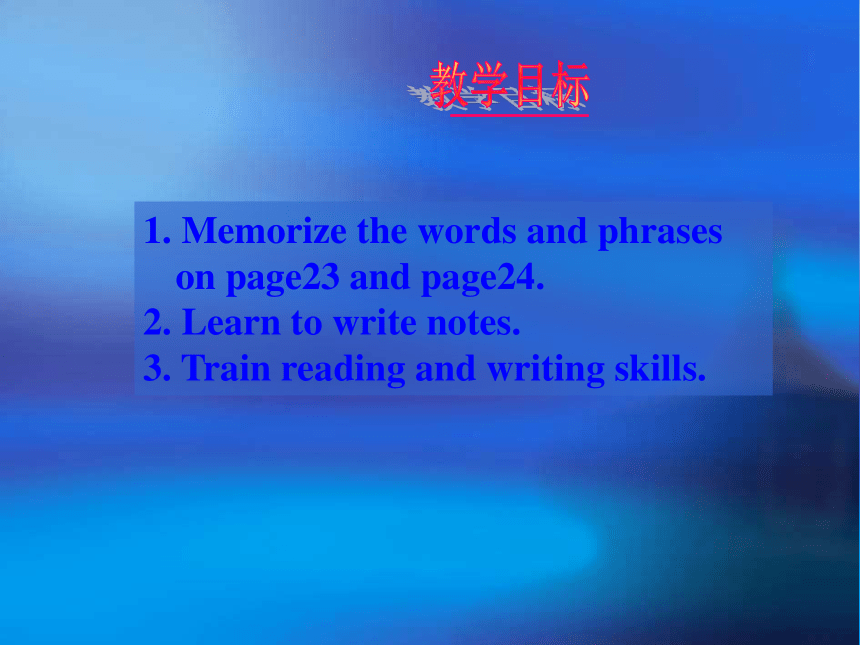 | |
| 格式 | zip | ||
| 文件大小 | 611.5KB | ||
| 资源类型 | 教案 | ||
| 版本资源 | 人教(新起点) | ||
| 科目 | 英语 | ||
| 更新时间 | 2013-02-22 11:14:21 | ||
图片预览

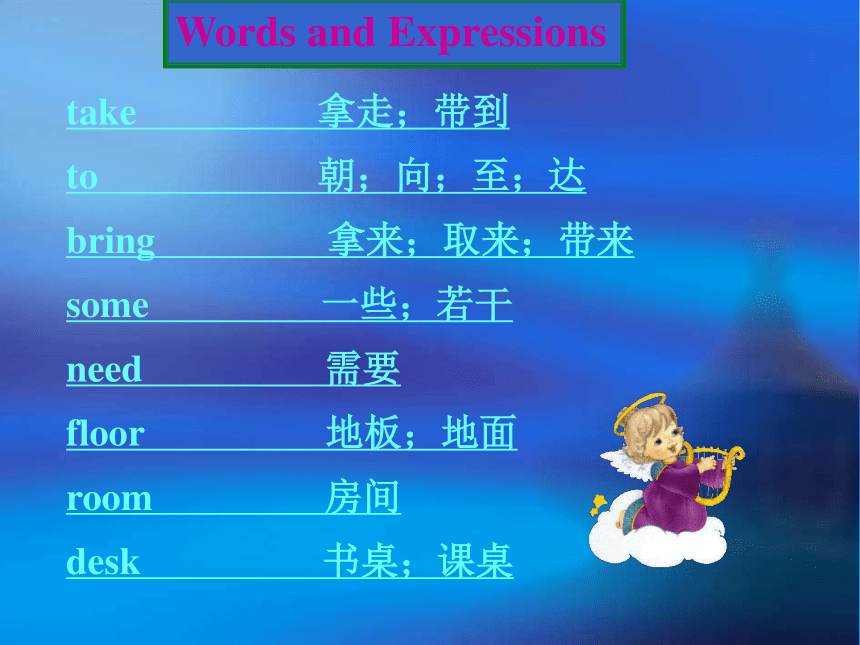
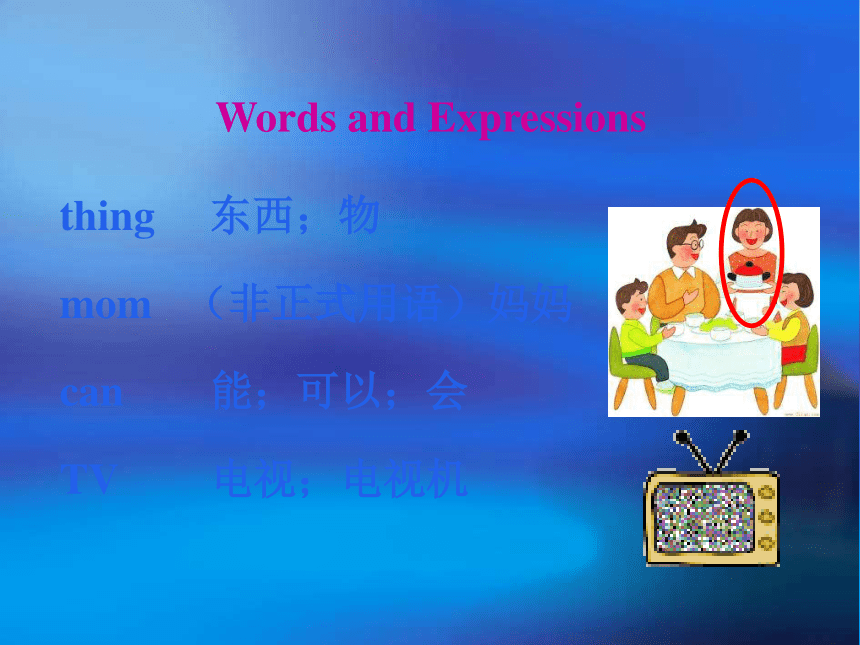

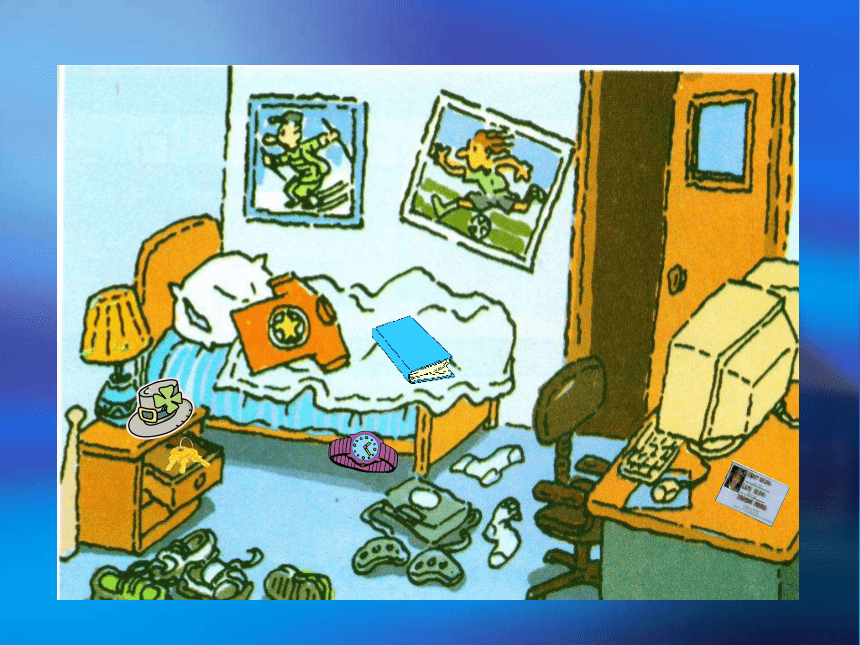
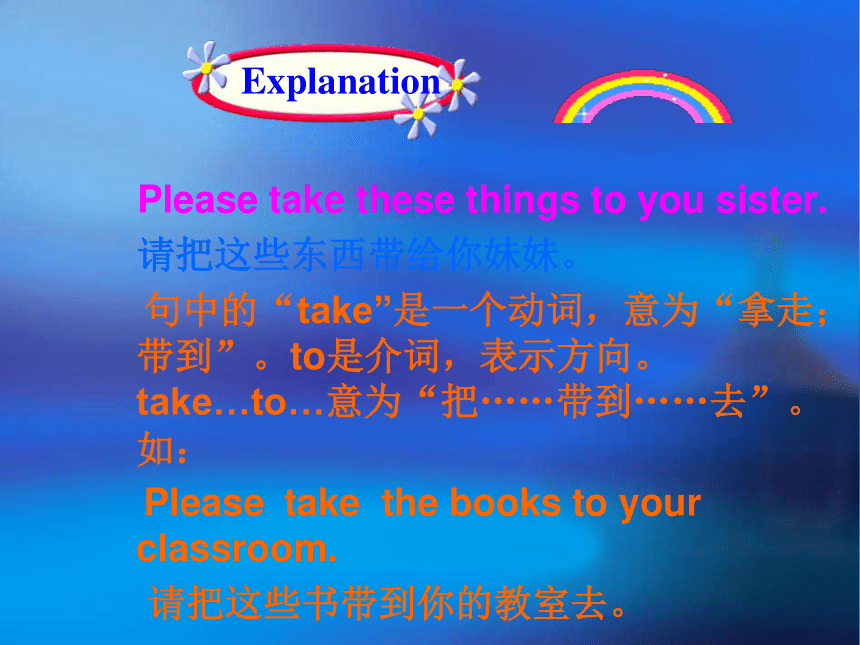
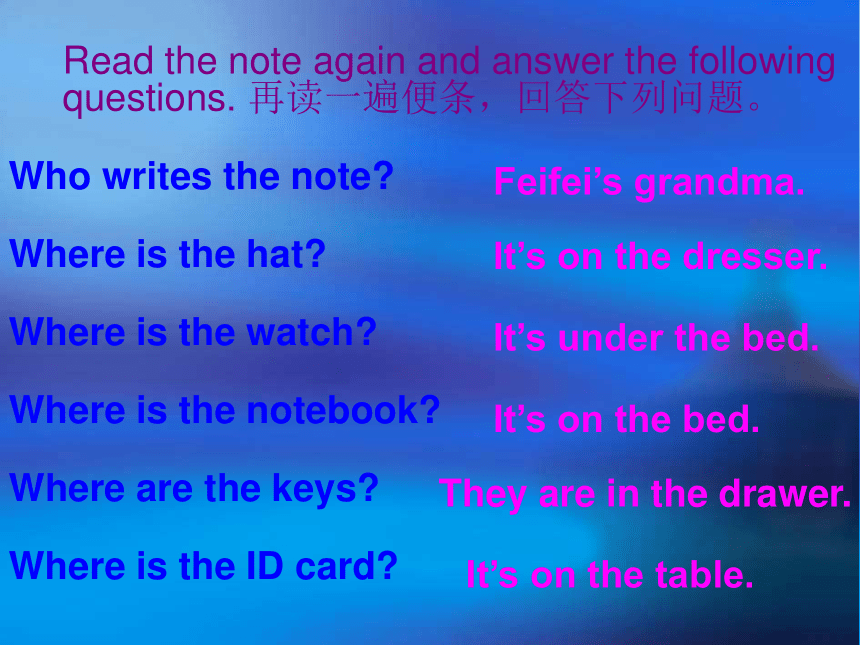
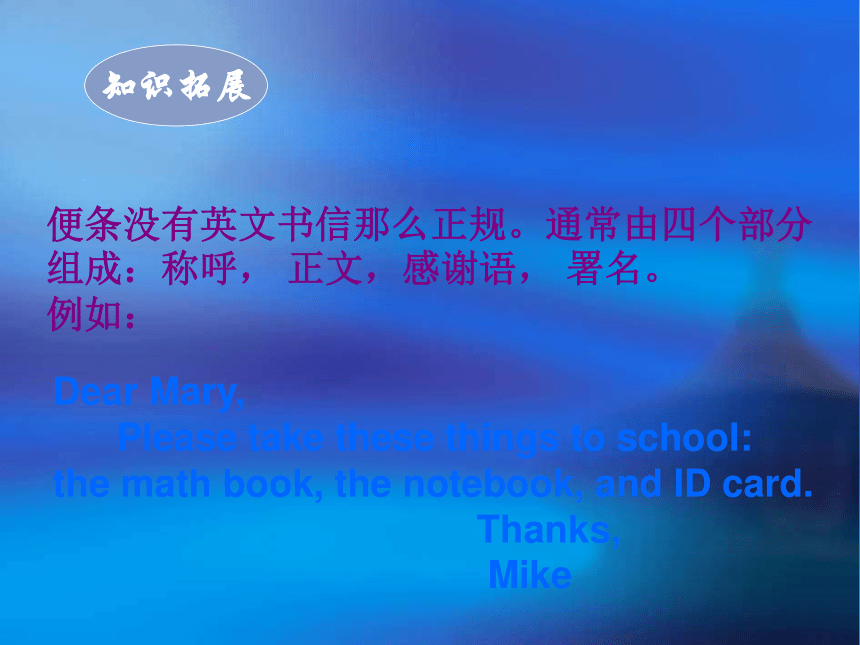
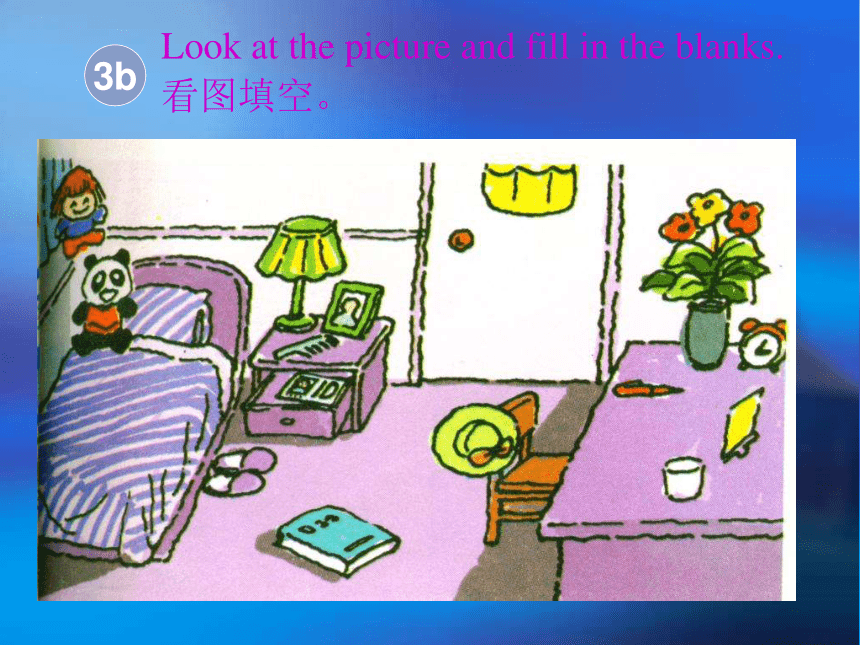
文档简介
(共20张PPT)
1. Memorize the words and phrases on page23 and page24.
2. Learn to write notes.
3. Train reading and writing skills.
Words and Expressions
take 拿走;带到
to 朝;向;至;达
bring 拿来;取来;带来
some 一些;若干
need 需要
floor 地板;地面
room 房间
desk 书桌;课桌
Words and Expressions
thing 东西;物
mom (非正式用语)妈妈
can 能;可以;会
TV 电视;电视机
Read the note and draw the missing things in the picture.
阅读便条,在图中画出缺少的物品。
Dear Feifei,
Please take these things to your sister: her hat, watch, notebook, keys and ID card. The hat is on the dresser. The watch is under the bed. The notebook is on the bed. The keys are in the drawer. The ID card is on the table.
Thanks,
Grandma
3a
Please take these things to you sister.
请把这些东西带给你妹妹。
句中的“take”是一个动词,意为“拿走;带到”。to是介词,表示方向。take…to…意为“把……带到……去”。如:
Please take the books to your classroom.
请把这些书带到你的教室去。
Explanation
Read the note again and answer the following questions. 再读一遍便条,回答下列问题。
Who writes the note
Where is the hat
Where is the watch
Where is the notebook
Where are the keys
Where is the ID card
Feifei’s grandma.
It’s on the dresser.
It’s under the bed.
It’s on the bed.
They are in the drawer.
It’s on the table.
知识拓展
便条没有英文书信那么正规。通常由四个部分组成:称呼, 正文,感谢语, 署名。
例如:
Dear Mary,
Please take these things to school: the math book, the notebook, and ID card.
Thanks,
Mike
Look at the picture and fill in the blanks.
看图填空。
3b
Dear Chenguang,
Can you bring some things to school I need my hat, my notebook, and a pen. My ___ is __________ . The ________ is __________ , and my ___ is __________.
Thanks,
Chenyang
hat
on the chair
notebook
on the floor
pen
on the table
3b
Can you bring some things to school
你能把一些东西带到学校来吗?
bring也是一个动词,意为“带来;拿来”。常与介词to连用,意为“把……带到……来”。它所表示的方向正好与take相反。
take和bring
take v.“拿走”指把某物从说话人所在的地
方取走。
bring v.“带来”指把某物带到说话人所在的
地方。
Explanation
can是一个情态动词,意为“能”,可用于任何的人称之后,不管句子的主语是什么人称,can后的动词一律用原形。
“Can you … ”是一个征求对方许可的句型,意为“你能……怎样吗?”,在语气上显得很有礼貌。如:
Can you help me read the words.
你能帮我读记读这些单词吗?
Explanation
some 一些、若干。修饰可数名词的复数或不可数名词,表示不定的数或量,如:
I have some questions to ask.
questions是可数名词的复数,“一些问题” 之意。
I want some milk for breakfast.
milk是不可数名词,“牛奶”之意。
Explanation
I need my hat, my notebook and a pen.
我需要我的帽子、笔记本和一支钢笔。
句中need用作动词,意为“需要”,它的后面可以直接跟名词或代词作宾语。如:
We need a pencil case.
我们需要一个钢笔盒。
I need your help.
我需要你的帮助。
Explanation
1. -______ my computer game
-______ in the drawer.
A. How’s; It’s B. Where’s; It’s
C. Where’re; They’re
解析:答语中“in the drawer”意为”在抽屉里“,是一个表示在点的介词短语。由此可推断前面询问的是地点,应使用where进行询问。句子的主语computer game是单数形式,所以系动词用is, 与之相对应的代词是it。
Practice
2. -Can you ______ her video cassette here
-OK.
A. take B. bring C. need
解析:take意为”带走“,在方向上由近及远。bring意为“带来”,在方向由远及近。need 意为“需要”。here意为“这儿”,由对话的情景可以看出,是强调把录象带(由远处)带到这儿来。
Practice
3. -Where is my CD
-I ______ know.
A. not B. am not C. don’t
解析:know是一个实义动词,意为 “知道”,
句子的主语是I ,构成否定时用助动词do的否定形式don’t。其实I don’t know.是口语交际中常用的一个短句,意为”我不知道。“。
Practice
4. -______ you answer the questions
-Sorry, I can’t.
A. Can B. Are C. Do
解析:answer是一个实义动词,在构成疑问时不能在前面加系动词,可排除B项。can与do都可以构成疑问,但句子在意思上不一样,can是一情态动词,意为”能“,在构成疑问时可以表示请求。do则没有这样的功能,它只是一个助动词,没有意思。再者,句子的答是”Sorry, I can’t”,从这个答语上也能做出判断。
Practice
1
Check the words you know.
table
bed
dresser
sofa
chair
book
computer game
hat
SELF
CHECK
在你认识的词语前打勾。
pencil case
backpack
key
math book
alarm clock
bookcase
baseball
CD
video tape
Read the note and draw the room.
读便条,画出房间。
This is my room. My hat is on the chair. My baseball is on the floor, under the bed. And those are my CDs. They are in my backpack.
3
1. Memorize the words and phrases on page23 and page24.
2. Learn to write notes.
3. Train reading and writing skills.
Words and Expressions
take 拿走;带到
to 朝;向;至;达
bring 拿来;取来;带来
some 一些;若干
need 需要
floor 地板;地面
room 房间
desk 书桌;课桌
Words and Expressions
thing 东西;物
mom (非正式用语)妈妈
can 能;可以;会
TV 电视;电视机
Read the note and draw the missing things in the picture.
阅读便条,在图中画出缺少的物品。
Dear Feifei,
Please take these things to your sister: her hat, watch, notebook, keys and ID card. The hat is on the dresser. The watch is under the bed. The notebook is on the bed. The keys are in the drawer. The ID card is on the table.
Thanks,
Grandma
3a
Please take these things to you sister.
请把这些东西带给你妹妹。
句中的“take”是一个动词,意为“拿走;带到”。to是介词,表示方向。take…to…意为“把……带到……去”。如:
Please take the books to your classroom.
请把这些书带到你的教室去。
Explanation
Read the note again and answer the following questions. 再读一遍便条,回答下列问题。
Who writes the note
Where is the hat
Where is the watch
Where is the notebook
Where are the keys
Where is the ID card
Feifei’s grandma.
It’s on the dresser.
It’s under the bed.
It’s on the bed.
They are in the drawer.
It’s on the table.
知识拓展
便条没有英文书信那么正规。通常由四个部分组成:称呼, 正文,感谢语, 署名。
例如:
Dear Mary,
Please take these things to school: the math book, the notebook, and ID card.
Thanks,
Mike
Look at the picture and fill in the blanks.
看图填空。
3b
Dear Chenguang,
Can you bring some things to school I need my hat, my notebook, and a pen. My ___ is __________ . The ________ is __________ , and my ___ is __________.
Thanks,
Chenyang
hat
on the chair
notebook
on the floor
pen
on the table
3b
Can you bring some things to school
你能把一些东西带到学校来吗?
bring也是一个动词,意为“带来;拿来”。常与介词to连用,意为“把……带到……来”。它所表示的方向正好与take相反。
take和bring
take v.“拿走”指把某物从说话人所在的地
方取走。
bring v.“带来”指把某物带到说话人所在的
地方。
Explanation
can是一个情态动词,意为“能”,可用于任何的人称之后,不管句子的主语是什么人称,can后的动词一律用原形。
“Can you … ”是一个征求对方许可的句型,意为“你能……怎样吗?”,在语气上显得很有礼貌。如:
Can you help me read the words.
你能帮我读记读这些单词吗?
Explanation
some 一些、若干。修饰可数名词的复数或不可数名词,表示不定的数或量,如:
I have some questions to ask.
questions是可数名词的复数,“一些问题” 之意。
I want some milk for breakfast.
milk是不可数名词,“牛奶”之意。
Explanation
I need my hat, my notebook and a pen.
我需要我的帽子、笔记本和一支钢笔。
句中need用作动词,意为“需要”,它的后面可以直接跟名词或代词作宾语。如:
We need a pencil case.
我们需要一个钢笔盒。
I need your help.
我需要你的帮助。
Explanation
1. -______ my computer game
-______ in the drawer.
A. How’s; It’s B. Where’s; It’s
C. Where’re; They’re
解析:答语中“in the drawer”意为”在抽屉里“,是一个表示在点的介词短语。由此可推断前面询问的是地点,应使用where进行询问。句子的主语computer game是单数形式,所以系动词用is, 与之相对应的代词是it。
Practice
2. -Can you ______ her video cassette here
-OK.
A. take B. bring C. need
解析:take意为”带走“,在方向上由近及远。bring意为“带来”,在方向由远及近。need 意为“需要”。here意为“这儿”,由对话的情景可以看出,是强调把录象带(由远处)带到这儿来。
Practice
3. -Where is my CD
-I ______ know.
A. not B. am not C. don’t
解析:know是一个实义动词,意为 “知道”,
句子的主语是I ,构成否定时用助动词do的否定形式don’t。其实I don’t know.是口语交际中常用的一个短句,意为”我不知道。“。
Practice
4. -______ you answer the questions
-Sorry, I can’t.
A. Can B. Are C. Do
解析:answer是一个实义动词,在构成疑问时不能在前面加系动词,可排除B项。can与do都可以构成疑问,但句子在意思上不一样,can是一情态动词,意为”能“,在构成疑问时可以表示请求。do则没有这样的功能,它只是一个助动词,没有意思。再者,句子的答是”Sorry, I can’t”,从这个答语上也能做出判断。
Practice
1
Check the words you know.
table
bed
dresser
sofa
chair
book
computer game
hat
SELF
CHECK
在你认识的词语前打勾。
pencil case
backpack
key
math book
alarm clock
bookcase
baseball
CD
video tape
Read the note and draw the room.
读便条,画出房间。
This is my room. My hat is on the chair. My baseball is on the floor, under the bed. And those are my CDs. They are in my backpack.
3
同课章节目录
